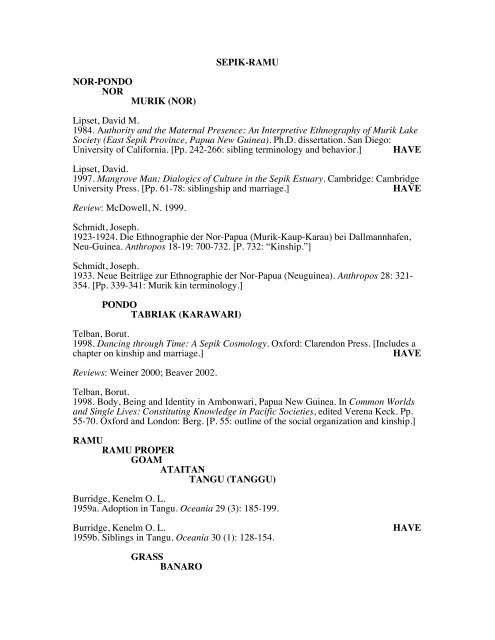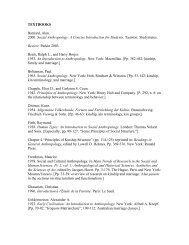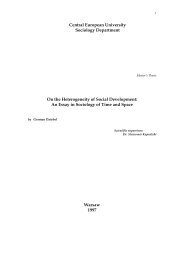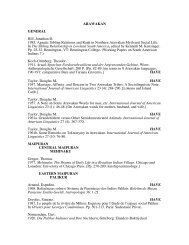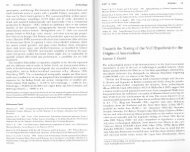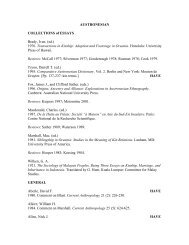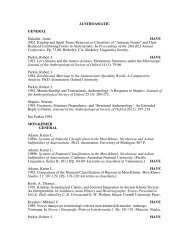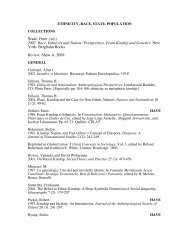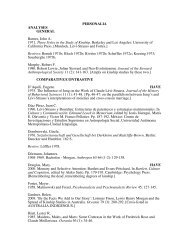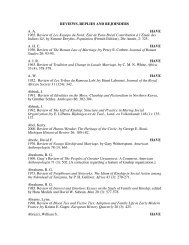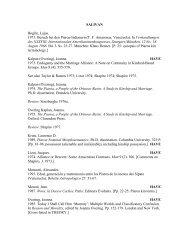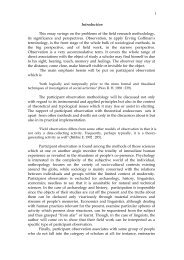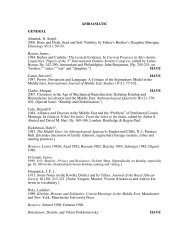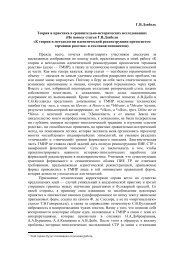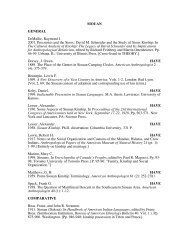SEPIK-RAMU NOR-PONDO NOR MURIK (NOR ... - Kinship Studies
SEPIK-RAMU NOR-PONDO NOR MURIK (NOR ... - Kinship Studies
SEPIK-RAMU NOR-PONDO NOR MURIK (NOR ... - Kinship Studies
Create successful ePaper yourself
Turn your PDF publications into a flip-book with our unique Google optimized e-Paper software.
<strong>NOR</strong>-<strong>PONDO</strong><br />
<strong>NOR</strong><br />
<strong>MURIK</strong> (<strong>NOR</strong>)<br />
<strong>SEPIK</strong>-<strong>RAMU</strong><br />
Lipset, David M.<br />
1984. Authority and the Maternal Presence: An Interpretive Ethnography of Murik Lake<br />
Society (East Sepik Province, Papua New Guinea). Ph.D. dissertation. San Diego:<br />
University of California. [Pp. 242-266: sibling terminology and behavior.] HAVE<br />
Lipset, David.<br />
1997. Mangrove Man: Dialogics of Culture in the Sepik Estuary. Cambridge: Cambridge<br />
University Press. [Pp. 61-78: siblingship and marriage.] HAVE<br />
Review: McDowell, N. 1999.<br />
Schmidt, Joseph.<br />
1923-1924. Die Ethnographie der Nor-Papua (Murik-Kaup-Karau) bei Dallmannhafen,<br />
Neu-Guinea. Anthropos 18-19: 700-732. [P. 732: “<strong>Kinship</strong>.”]<br />
Schmidt, Joseph.<br />
1933. Neue Beiträge zur Ethnographie der Nor-Papua (Neuguinea). Anthropos 28: 321-<br />
354. [Pp. 339-341: Murik kin terminology.]<br />
<strong>PONDO</strong><br />
TABRIAK (KARAWARI)<br />
Telban, Borut.<br />
1998. Dancing through Time: A Sepik Cosmology. Oxford: Clarendon Press. [Includes a<br />
chapter on kinship and marriage.] HAVE<br />
Reviews: Weiner 2000; Beaver 2002.<br />
Telban, Borut.<br />
1998. Body, Being and Identity in Ambonwari, Papua New Guinea. In Common Worlds<br />
and Single Lives: Constituting Knowledge in Pacific Societies, edited Verena Keck. Pp.<br />
55-70. Oxford and London: Berg. [P. 55: outline of the social organization and kinship.]<br />
<strong>RAMU</strong><br />
<strong>RAMU</strong> PROPER<br />
GOAM<br />
ATAITAN<br />
TANGU (TANGGU)<br />
Burridge, Kenelm O. L.<br />
1959a. Adoption in Tangu. Oceania 29 (3): 185-199.<br />
Burridge, Kenelm O. L. HAVE<br />
1959b. Siblings in Tangu. Oceania 30 (1): 128-154.<br />
GRASS<br />
BANARO
Guhr, G.<br />
1959. Die Geistheirat der Banaro (Neu-Guinea). Ethnographisch-Archäologische<br />
Forschungen 6: 161-191.<br />
Guhr, G.<br />
1959. Die Geistheirat der Banaro (Neu-Guinea). Anthropos 54: 590.<br />
Juillerat, Bernard.<br />
2000. Do the Banaro Really Exist? Going Back after Richard Thurnwald. Oceania 71 (1):<br />
46-66.<br />
Thurnwald, Richard. HAVE<br />
1916. Bánaro Society: Social Organization and <strong>Kinship</strong> System of a Tribe in the Interior<br />
of New Guinea. Memoirs of the American Anthropological Association 3 (4): 251-391.<br />
Thurnwald, Richard.<br />
1921. Die Gemeinde der Banaro. Ehe, Verwandtschaft und Gesellschaftsbau eines<br />
Stammes im Innern von Neu-Guinea. Aus den Ergebnissen einer Forschungsreise 1913-<br />
15. Stuttgart: Verlag von Ferdinand Enke.<br />
RUBONI<br />
MISEGIAN<br />
KIRE<br />
Stanhope, John M.<br />
1972. The Language of the Kire People, Bogia, Madang District, New Guinea. Anthropos<br />
67: 49-71. [P. 66: kin terminology and diagram.] HAVE<br />
OTILIEN<br />
KAEAN<br />
Meiser, Leo.<br />
1958. Relationship and Marriage among the Kaean of the Northern Coast of New Guinea.<br />
Anthropos 53: 806-816. [Pp. 806-807: kin terms for ascending and descending<br />
generations.] HAVE<br />
YUAT-WAIBUK<br />
YUAT-MARAMBA<br />
YUAT<br />
BUN<br />
McDowell, Nancy A.<br />
1975. <strong>Kinship</strong> and the Concept of Shame in a New Guinea Village. Ph.D. dissertation.<br />
Cornell University. [Pp. 87-94: Bun kin terminology.] HAVE<br />
MUNDUGUMOR (BIWAT)<br />
Kessel, R.<br />
1971. A Reinterpretation of Mundugumor Ropes as a Non-Descent System. Creeley:<br />
University of Northern Colorado. (Museum of Anthropology Miscellaneous Papers 24.)<br />
McDowell, Nancy.<br />
1977. The Meaning of ‘Rope’ in a Yuat River Village. Ethnology 16: 175-184.
McDowell, Nancy. HAVE<br />
1991. The Mundugumor: From the Field Notes of Margaret Mead and Reo Fortune.<br />
Washington and London: Smithsonian Institution Press. [Pp. 168ff: kin terminology.]<br />
<strong>SEPIK</strong><br />
GENERAL<br />
Harrison, Simon. HAVE<br />
1985. Names, Ghosts and Alliance in Two Sepik Societies. Oceania 56 (2): 138-146.<br />
[Manambu and Iatmul.]<br />
MIDDLE <strong>SEPIK</strong><br />
NDU<br />
ABELAM<br />
Gorlin, Peter.<br />
1973. Health, Wealth and Agnation among the Abelam: The Beginning of Social<br />
Stratification in New Guinea. Ph.D. dissertation. Columbia University.<br />
Huber-Greub, Barbara.<br />
1988. Kokospalmenmenschen: Boden und Alltag und ihre Bedeutung im Selbstverstandis<br />
der Abelam von Kimbangwa. Basel, Switzerland: Ethnologisches Seminar der Universität<br />
und Museum fur Völkerkunde. [Pp. 47-71: kinship, marriage and adoption. Includes kin<br />
terminology.] HAVE<br />
Kaberry, Phyllis M. HAVE<br />
1941. The Abelam Tribe, Sepik District, New Guinea. Oceania 11 (3): 233-258.<br />
Schroeder, Roger.<br />
1992. Initiation and Religion: A Case Study from the Wosera of Papua New Guinea.<br />
Fribourg, Switzerland: University Press. [Pp. 81-99: Abelam marriage.]<br />
IATMUL<br />
Bateson, Gregory. HAVE<br />
1932. Social Structure of the Iatmul People of the Sepik River. Oceania 2 (3): 245-291.<br />
Bateson, Gregory.<br />
1936. Naven: A Survey of the Problems Suggested by a Composite Picture of the Culture<br />
of a New Guinea Tribe Drawn from Three Points of View. Cambridge: Cambridge<br />
University Press.<br />
Forge, Anthony.<br />
1971. Marriage and Exchange in the Sepik: Comments on Francis Korn’s Analysis of<br />
Iatmul Society. In Rethinking <strong>Kinship</strong> and Marriage, edited by Rodney Needham. Pp.<br />
133-144. London, etc.: Tavistock Publications.<br />
Houseman, Michael, and Carlo Severi.<br />
1994. Naven ou le Donner à Voir. Essai d'Interpretation de l'Action Rituelle. Paris:<br />
CNRS Éditions, Éditions de la Maison des Sciences de l’Homme. [Pp. 81-120: Iatmul<br />
kinship and marriage alliance. Reinterpretation of Bateson.]<br />
Houseman, Michael, and Carlo Severi.
1998. Naven or the Other Self: A Relational Approach to Ritual Action. Translated from<br />
the French by Michael Fineberg. Leiden, etc.: Brill. [Pp. 73-117: “Wife-Givers and Wife-<br />
Takers.” Iatmul kinship and marriage alliance. Reinterpretation of Bateson.]<br />
Korn, Francis.<br />
1971. A Question of Preferences: The Iatmul Case. In Rethinking <strong>Kinship</strong> and Marriage,<br />
edited by Rodney Needham. Pp. 99-132. London, etc.: Tavistock Publications.<br />
Silverman, Eric Kline<br />
1993. Tambunum: New Perspectives on Eastern Iatmul (Sepik River, Papua New Guinea)<br />
<strong>Kinship</strong>, Marriage, and Society. Ph.D. dissertation. University of Minnesota.<br />
Stanek, Milan.<br />
1983. Sozialordnung und Mythik in Palimbei. Bausteine zur Ganzheitlichen<br />
Beschreibung einer Dorfgemeinschaft der Iatmul, East Sepik Province, Papua New<br />
Guinea. Basel: Ethnologisches Seminar der Universität und Museum für Völkerkunde.<br />
[Pp. 62-189: “The Problem of <strong>Kinship</strong>.” Includes kin terminology.]<br />
Stanek, Milan.<br />
1990. Social Structure of the Iatmul. In Sepik Heritage: Tradition and Change in Papua<br />
New Guinea, edited by N. Lutkehaus et al. Durham: Carolina Academic Press.<br />
Wassmann, Jürg.<br />
1991. The Song of the Flying Fox: The Public and Esoteric Knowledge of the Important<br />
Men of Kandingei about Totemic Songs, Names and Knotted Cords (Middle Sepik, Papua<br />
New Guinea). Boroko, PNG: National Research Institute. [Pp. 38-39: Iatmul kin<br />
terminology.] HAVE<br />
NUKUMA<br />
KWANGA (APOS)<br />
Eeuwijk, Brigit O. van.<br />
1992, Small But Strong: Cultural Contexts of (Mal-)Nutrition among the Northern<br />
Kwanga (East Sepik Proivince, Papua New Guinea). Basel: Ethnologisches Seminar der<br />
Universität und Museum für Völkerkunde. (Basler Beiträge zur Ethnologie 34.) [Pp. 53-<br />
58: kin terminology and descent groups.] HAVE<br />
Manabe, Takashi.<br />
1988. Mami Reveals Dynamic Kwanga Social Structure. In Nucleation in Papua New<br />
Guinea Cultures, edited by Marvin K. Mayers and Daniel D. Rath. Pp. 45-60. Dallas,<br />
TX: International Museum of Cultures. [No kin terms given.]<br />
KWOMA<br />
Bowden, Ross. HAVE<br />
1983. Kwoma Terminology and Marriage Alliance: The ‘Omaha’ Problem Revisited.<br />
Man 18 (4): 745-765.<br />
Bowden, Ross.<br />
1988. Kwoma Death Payments and Alliance Theory. Ethnology 27 (3): 271-290.<br />
Whiting, John W. M.<br />
1941. Becoming a Kwoma: Teaching and Learning in a New Guinea Tribe. New Haven:<br />
Yale University Press. [Pp. 7-9: general description of an “Omaha” kin terminology.]
<strong>SEPIK</strong> HILL<br />
ALAMBLAK<br />
Bruce, Leslie P. HAVE<br />
1974. Alamblak Kinsmen: To Give Is Better Than to Receive (and You’ll Get It Back).<br />
In <strong>Kinship</strong> <strong>Studies</strong> in Papua New Guinea, edited by Daniel R. Shaw. Pp. 169-186.<br />
Ukarumpa, Papua New Guinea: Summer Institute of Linguistics.<br />
SANIO<br />
HEWA<br />
Steadman, Lyle. HAVE<br />
1980. The Hewa of the Lagaip River. In Blood and Semen: <strong>Kinship</strong> Systems of Highland<br />
New Guinea, edited by Edwin A. Cook and Denise O’Brien. Pp. 299-304. Ann Arbor:<br />
University of Michigan Press.<br />
SANIO-HIYEWE<br />
Lewis, Ronald K.<br />
1988. The Interrelationship of Taboo and <strong>Kinship</strong> as the Cohesive Agent of Saniyo-<br />
Hiyowe Society. In Nucleation in Papua New Guinea Cultures, edited by Marvin K.<br />
Mayers and Daniel D. Rath. Pp. 61-70. Dallas, TX: International Museum of Cultures.<br />
[No kin terms given.]<br />
Townsend, Patricia K. W.<br />
1969. Subsistence and Social Organization in a New Guinea Society. Ph.D. dissertation.<br />
Ann Arbor: University of Michigan. [Pp. 148-157, 194-199: Sanio (Saniyo-Hiyewe) kin<br />
terminology.] HAVE<br />
UPPER <strong>SEPIK</strong><br />
IWAM<br />
Laszlo, Marilyn J., and Shirley A Killosky.<br />
1990-1995 (?). An Anthropological Description of Hauna Village: The Sepik Iwam<br />
Language Group, edited by Glenda S. Dobbs. Written for the Summer Institute of<br />
Linguistics, Papua New Guinea. 216 P. [Discusses Sepik Iwam marriage and kin<br />
groupings. Pp. 116-124: kin terminology.]<br />
Rehburg, Judith. HAVE<br />
1974. Social Structure of the Sepik Iwam. In <strong>Kinship</strong> <strong>Studies</strong> in Papua New Guinea,<br />
edited by Daniel R. Shaw. Pp. 211-222. Ukarumpa, Papua New Guinea: Summer<br />
Institute of Linguistics.<br />
YELLOW RIVER<br />
GENERAL<br />
Kelm, Antje, and Heinz Kelm.<br />
1980. Sago und Schwein. Ethnologie von Kwieftim und Abrau in Nordost Neuguinea.<br />
Wiesbaden: Franz Steiner. [Ak and Awun; Pp. 220-293: “Social Strcuture.”]<br />
YIMAR
Haberland, Eike, and Siegfried Seyfarth.<br />
1974. Die Yimar am Oberen Korowori. Wiesbaden: Franz Steiner. [Pp. 252-270: kinship,<br />
clans and myths. No terminology given.]


